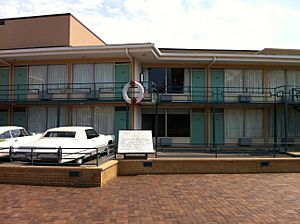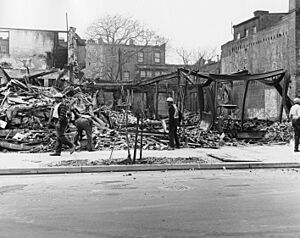Assassination of Martin Luther King Jr. facts for kids
Quick facts for kids Assassination of Martin Luther King Jr. |
|
|---|---|

Lorraine Motel in 2012. The wreath marks King's approximate location at the time of his assassination.
|
|
| Location | Lorraine Motel Memphis, Tennessee, U.S. |
| Coordinates | 35°08′04″N 90°03′27″W / 35.1345°N 90.0576°W |
| Date | April 4, 1968 6:01 p.m. (CST (UTC–6)) |
| Target | Martin Luther King Jr. |
|
Attack type
|
Sniper assassination |
| Weapons | Remington 760 Gamemaster .30-06 |
| Deaths | Martin Luther King Jr. |
| Perpetrators |
|
Martin Luther King Jr. was a very important leader in the civil rights movement. He won the Nobel Peace Prize for his work. He was known for using nonviolence and peaceful protests to make big changes.
On April 4, 1968, at 6:01 p.m., he was shot and killed. This happened at the Lorraine Motel in Memphis, Tennessee. He was taken to St. Joseph's Hospital but sadly died at 7:05 p.m.
A man named James Earl Ray was arrested for the crime. He was caught on June 8, 1968, in London, England. Ray later said he was guilty and was sent to prison. He tried many times to change his plea and get a trial, but he was not successful. Ray died in prison in 1998.
This event was one of several important killings in the 1960s in the United States. It happened after the assassination of John F. Kennedy in 1963 and the assassination of Malcolm X in 1965. It was also two months before the assassination of Robert F. Kennedy in June 1968.
Contents
Why Martin Luther King Jr. Was in Memphis
Threats Against His Life
From the mid-1950s, Martin Luther King Jr. received many threats. This was because he was a major leader in the civil rights movement. He knew his life was in danger. In 1958, he was even badly hurt in an attack.
King believed that violence could not stop the fight for equal rights. After President Kennedy was killed in 1963, King told his wife, Coretta Scott King, that he thought the same thing would happen to him.
Supporting Workers in Memphis
King went to Memphis, Tennessee, to help African-American city workers. These workers were on strike. They had stopped working on February 11, 1968. They were protesting unfair pay and bad working conditions.
At that time, black workers in Memphis were paid much less than white workers. They did not have uniforms or proper restrooms. They also had no way to complain if they were underpaid. The mayor, Henry Loeb, did not improve things. This led to the workers going on strike.
King joined a large march in Memphis on March 28, 1968. This march ended with some violence. King returned to Memphis on April 3 to try another peaceful march. His flight was delayed by a bomb threat. But he still arrived in time to give a speech. He spoke at the Mason Temple.
At the Mason Temple, King gave his famous "I've Been to the Mountaintop" speech. In this speech, he talked about the 1958 attack on him. He also spoke about the recent bomb threat. He said he might not live to see the "promised land" of equality. But he was sure that his people would get there.
The Assassination Event
On Thursday, April 4, 1968, King was staying at the Lorraine Motel in Memphis. He was in room 306. This room was often called the "King–Abernathy Suite." This was because King and his friend, Reverend Ralph Abernathy, stayed there often.
According to his biographer, King's last words were to a musician named Ben Branch. King asked him to play a song called "Take My Hand, Precious Lord" that night. He said, "Play it real pretty."
King was leaning over the balcony railing outside his room. He was talking to Rev. Jesse Jackson. Then, a shot was fired at 6:01 p.m. King was hit by a single bullet from a rifle. He fell backward onto the balcony.
Ralph Abernathy heard the shot from inside the room. He ran out and found King on the balcony. Andrew Young, another colleague, thought King was dead. But he found that King still had a pulse.
King was quickly taken to St. Joseph's Hospital. Doctors tried to save him, but he never woke up. He died at 7:05 p.m. An examination showed that King's heart was like that of a 60-year-old. This was likely due to the stress of his work for civil rights.
Soon after the shot, witnesses saw a man running from a building across the street. This man was later believed to be James Earl Ray. Police found a rifle and binoculars nearby. Both had Ray's fingerprints on them. Ray had bought the rifle under a fake name a few days earlier. Police searched for him around the world. He was arrested in London two months later.
After the Assassination
Riots Across the Country
King's friends and colleagues asked people to respond peacefully. They wanted to honor King's belief in nonviolence. But despite their pleas, riots broke out in over 100 cities across the country.

After King's death, the city of Memphis quickly settled the strike. The sanitation workers received better pay and conditions.
King's Funeral
About 300,000 people attended King's funeral on April 9. Vice President Hubert Humphrey went to the funeral. He represented President Johnson, who was at a meeting about the Vietnam War.
At his wife's request, King's last sermon was played at the funeral. It was called the "Drum Major" sermon. In it, he asked that no one mention his awards at his funeral. Instead, he wanted people to say he tried to "feed the hungry" and "love and serve humanity."
Images for kids
See also
 In Spanish: Asesinato de Martin Luther King para niños
In Spanish: Asesinato de Martin Luther King para niños
- Assassination of Malcolm X
- "I've Been to the Mountaintop"
- Post–civil rights era in African-American history





